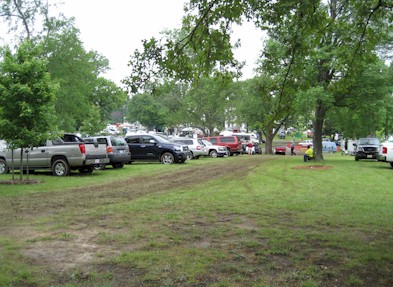
Before our hike we spent a little time along Cold Creek in the Harmon Den area. There were hundreds of butterflies drawn to the salt deposits along the road so we have a few dozen pictures that look like this.

Mid-May is a great time to hike in the area because of the wildflowers. We headed north bound on the A.T. from Brown Gap, which starts with a decent climb but is relatively gentle and rolling after that.

The trilliums were particularly abundant. They’re a bit hard to see in this picture but all those specks of white and pink are trillium. It was pretty much deserted on this part of the mountain until we reached Max Patch. We decided not to climb to the top on this particular day. Instead we let Trout lie in a stream and cool off while we studied the map.
We decided we could take an alternate route back to Brown Gap. This started by taking the A.T. southbound for a quarter mile or so to the junction with the Cherry Creek Trail. We then took the Cherry Creek trail for maybe a half mile or so until it intersected an old forest service road (named 3533 on some maps). We left Cherry Creek Trail and followed the road along the ridge. This worked out great for a while at least. The road was broad and easy to follow and it was paralleling the A.T. about 200 ft below it. This is how it looked with a dog in the middle:

About halfway back to Brown Gap the road ends. This was not entirely unexpected as our A.T. map also showed the road ending. Our plan was to orienteer from here by following the 4000 ft. contour line around the ridge until it intersected the A.T. which would be descending towards Brown Gap at that point. Even in May the forest was pretty thick and there was a lot of sharp foliage (blackberries in particular). So when we encountered a really old road bed we decided to follow that instead. This road bed was long unusued and had substantial trees growing in it as well as fallen across it. It was quite clear that bears and deer used it though. Melanie’s theory was that it would connect directly into Brown Gap as we had noticed an old road leaving from a campsite there on our way out. In the end, she was right although it’s a bit of a circuitous route it takes to get there. We did it all with the A.T. map, a compass and an altimeter but I think if we did it again, a better topo map might help. On the other hand, it would be hard to get seriously lost in this area since everything on this side of the Appalachian Trail drains down to Harmon Den Road.


















































